
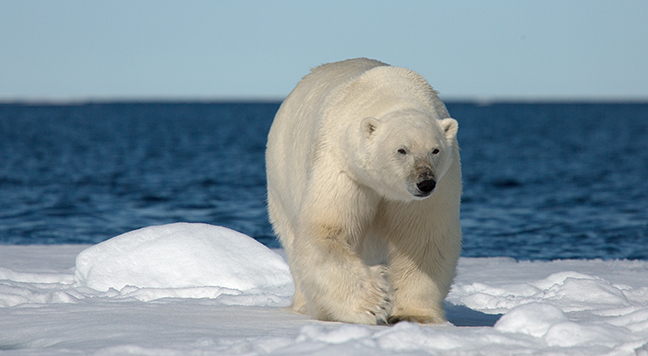
Polar Bears are the world’s largest land carnivores. Svalbard’s bears are part of the Barents Sea population which covers the area from Spitsbergen in the west to the Russian archipelagos of Franz Josef Land and Novaya Zemlya in the east. In Svalbard, the polar bear’s main prey are ringed and bearded seals and harp seals in offshore habitats. They feed almost exclusively on ice-living seals. A healthy adult polar bear kills between 50 and 75 seals annually to meet its energy requirements.
The harvesting of polar bears is regulated by a multilateral treaty signed in Oslo on November 15, 1973 by the five nations with the largest polar bear populations: Canada, Denmark (Greenland), Norway (Svalbard), the United States and the Soviet Union. Climate change is expected to cause serious problems for polar bears. Reductions in the ice pack will create difficulty in the hunting of seals and have a profound effect. Polar bears are also at risk from consuming prey that accumulated pollutants from lower trophic levels. (1/19)
©Rich Beckman

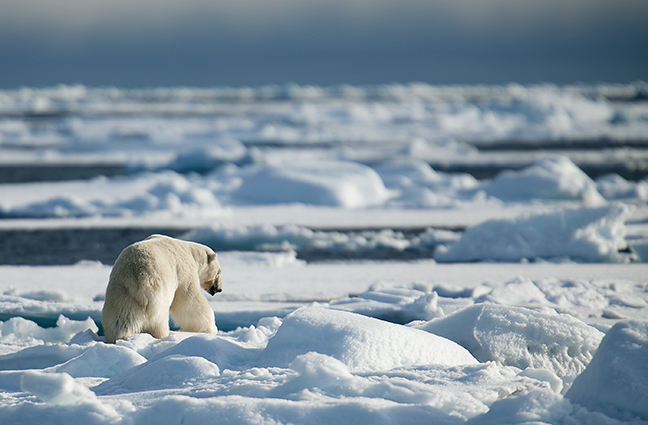
Polar Bears are the world’s largest land carnivores. Svalbard’s bears are part of the Barents Sea population which covers the area from Spitsbergen in the west to the Russian archipelagos of Franz Josef Land and Novaya Zemlya in the east. In Svalbard, the polar bear’s main prey are ringed and bearded seals and harp seals in offshore habitats. They feed almost exclusively on ice-living seals. A healthy adult polar bear kills between 50 and 75 seals annually to meet its energy requirements.
The harvesting of polar bears is regulated by a multilateral treaty signed in Oslo on November 15, 1973 by the five nations with the largest polar bear populations: Canada, Denmark (Greenland), Norway (Svalbard), the United States and the Soviet Union. Climate change is expected to cause serious problems for polar bears. Reductions in the ice pack will create difficulty in the hunting of seals and have a profound effect. Polar bears are also at risk from consuming prey that accumulated pollutants from lower trophic levels. (2/19)
©Rich Beckman

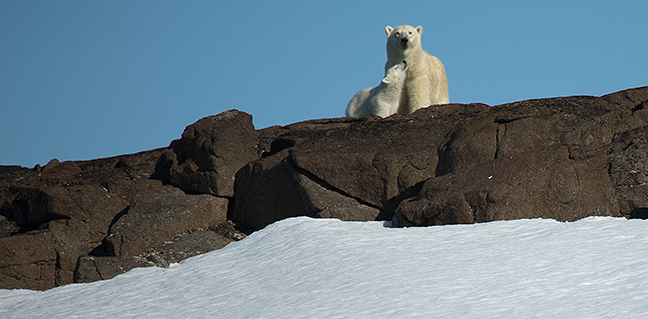
Polar Bears are the world’s largest land carnivores. Svalbard’s bears are part of the Barents Sea population which covers the area from Spitsbergen in the west to the Russian archipelagos of Franz Josef Land and Novaya Zemlya in the east. In Svalbard, the polar bear’s main prey are ringed and bearded seals and harp seals in offshore habitats. They feed almost exclusively on ice-living seals. A healthy adult polar bear kills between 50 and 75 seals annually to meet its energy requirements.
The harvesting of polar bears is regulated by a multilateral treaty signed in Oslo on November 15, 1973 by the five nations with the largest polar bear populations: Canada, Denmark (Greenland), Norway (Svalbard), the United States and the Soviet Union. Climate change is expected to cause serious problems for polar bears. Reductions in the ice pack will create difficulty in the hunting of seals and have a profound effect. Polar bears are also at risk from consuming prey that accumulated pollutants from lower trophic levels. (3/19)
©Rich Beckman

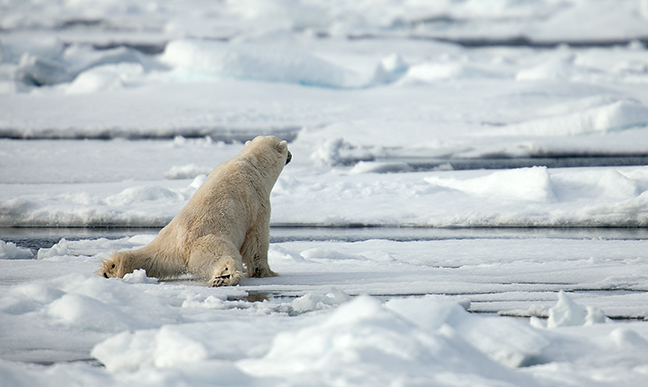
Polar Bears are the world’s largest land carnivores. Svalbard’s bears are part of the Barents Sea population which covers the area from Spitsbergen in the west to the Russian archipelagos of Franz Josef Land and Novaya Zemlya in the east. In Svalbard, the polar bear’s main prey are ringed and bearded seals and harp seals in offshore habitats. They feed almost exclusively on ice-living seals. A healthy adult polar bear kills between 50 and 75 seals annually to meet its energy requirements.
The harvesting of polar bears is regulated by a multilateral treaty signed in Oslo on November 15, 1973 by the five nations with the largest polar bear populations: Canada, Denmark (Greenland), Norway (Svalbard), the United States and the Soviet Union. Climate change is expected to cause serious problems for polar bears. Reductions in the ice pack will create difficulty in the hunting of seals and have a profound effect. Polar bears are also at risk from consuming prey that accumulated pollutants from lower trophic levels. (4/19)
©Rich Beckman

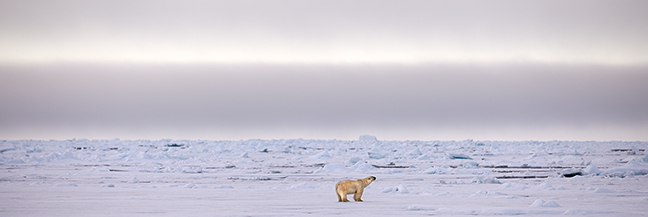
Polar Bears are the world’s largest land carnivores. Svalbard’s bears are part of the Barents Sea population which covers the area from Spitsbergen in the west to the Russian archipelagos of Franz Josef Land and Novaya Zemlya in the east. In Svalbard, the polar bear’s main prey are ringed and bearded seals and harp seals in offshore habitats. They feed almost exclusively on ice-living seals. A healthy adult polar bear kills between 50 and 75 seals annually to meet its energy requirements.
The harvesting of polar bears is regulated by a multilateral treaty signed in Oslo on November 15, 1973 by the five nations with the largest polar bear populations: Canada, Denmark (Greenland), Norway (Svalbard), the United States and the Soviet Union. Climate change is expected to cause serious problems for polar bears. Reductions in the ice pack will create difficulty in the hunting of seals and have a profound effect. Polar bears are also at risk from consuming prey that accumulated pollutants from lower trophic levels. (5/19)
©Rich Beckman

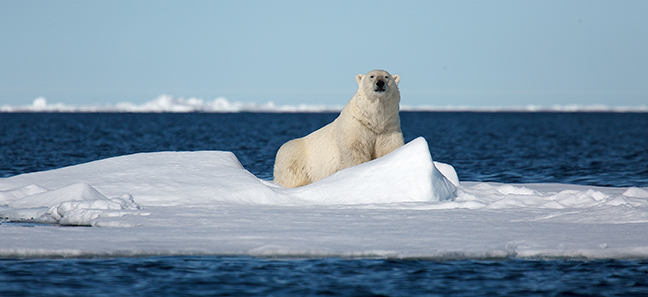
Polar Bears are the world’s largest land carnivores. Svalbard’s bears are part of the Barents Sea population which covers the area from Spitsbergen in the west to the Russian archipelagos of Franz Josef Land and Novaya Zemlya in the east. In Svalbard, the polar bear’s main prey are ringed and bearded seals and harp seals in offshore habitats. They feed almost exclusively on ice-living seals. A healthy adult polar bear kills between 50 and 75 seals annually to meet its energy requirements.
The harvesting of polar bears is regulated by a multilateral treaty signed in Oslo on November 15, 1973 by the five nations with the largest polar bear populations: Canada, Denmark (Greenland), Norway (Svalbard), the United States and the Soviet Union. Climate change is expected to cause serious problems for polar bears. Reductions in the ice pack will create difficulty in the hunting of seals and have a profound effect. Polar bears are also at risk from consuming prey that accumulated pollutants from lower trophic levels. (6/19)
©Rich Beckman

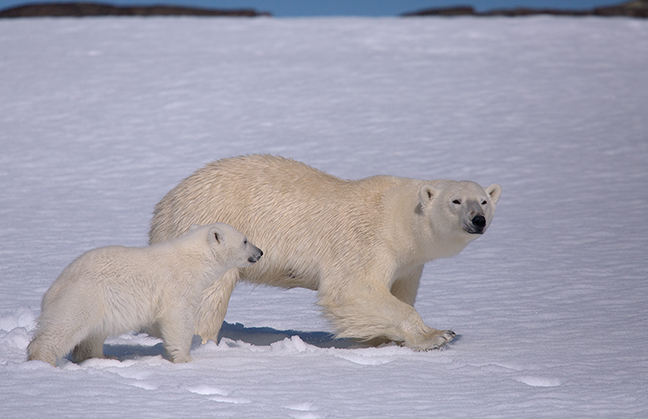
Polar Bears are the world’s largest land carnivores. Svalbard’s bears are part of the Barents Sea population which covers the area from Spitsbergen in the west to the Russian archipelagos of Franz Josef Land and Novaya Zemlya in the east. In Svalbard, the polar bear’s main prey are ringed and bearded seals and harp seals in offshore habitats. They feed almost exclusively on ice-living seals. A healthy adult polar bear kills between 50 and 75 seals annually to meet its energy requirements.
The harvesting of polar bears is regulated by a multilateral treaty signed in Oslo on November 15, 1973 by the five nations with the largest polar bear populations: Canada, Denmark (Greenland), Norway (Svalbard), the United States and the Soviet Union. Climate change is expected to cause serious problems for polar bears. Reductions in the ice pack will create difficulty in the hunting of seals and have a profound effect. Polar bears are also at risk from consuming prey that accumulated pollutants from lower trophic levels. (7/19)
©Rich Beckman

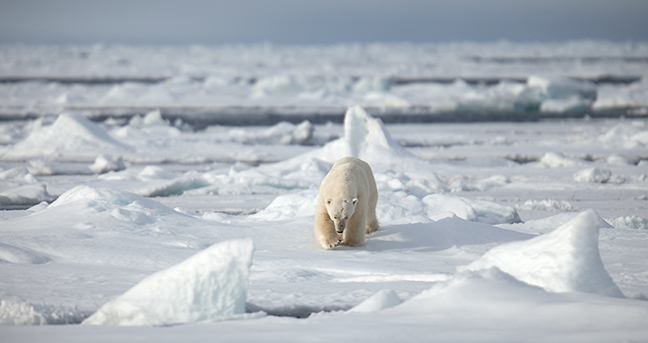
Polar Bears are the world’s largest land carnivores. Svalbard’s bears are part of the Barents Sea population which covers the area from Spitsbergen in the west to the Russian archipelagos of Franz Josef Land and Novaya Zemlya in the east. In Svalbard, the polar bear’s main prey are ringed and bearded seals and harp seals in offshore habitats. They feed almost exclusively on ice-living seals. A healthy adult polar bear kills between 50 and 75 seals annually to meet its energy requirements.
The harvesting of polar bears is regulated by a multilateral treaty signed in Oslo on November 15, 1973 by the five nations with the largest polar bear populations: Canada, Denmark (Greenland), Norway (Svalbard), the United States and the Soviet Union. Climate change is expected to cause serious problems for polar bears. Reductions in the ice pack will create difficulty in the hunting of seals and have a profound effect. Polar bears are also at risk from consuming prey that accumulated pollutants from lower trophic levels. (8/19)
©Rich Beckman

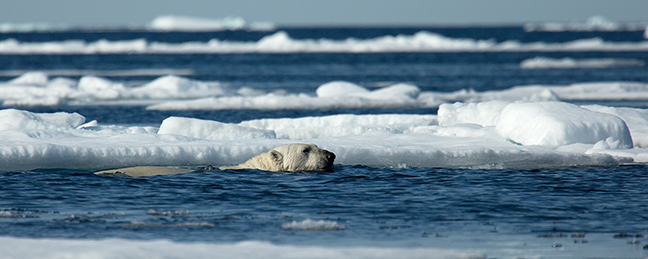
Polar Bears are the world’s largest land carnivores. Svalbard’s bears are part of the Barents Sea population which covers the area from Spitsbergen in the west to the Russian archipelagos of Franz Josef Land and Novaya Zemlya in the east. In Svalbard, the polar bear’s main prey are ringed and bearded seals and harp seals in offshore habitats. They feed almost exclusively on ice-living seals. A healthy adult polar bear kills between 50 and 75 seals annually to meet its energy requirements.
The harvesting of polar bears is regulated by a multilateral treaty signed in Oslo on November 15, 1973 by the five nations with the largest polar bear populations: Canada, Denmark (Greenland), Norway (Svalbard), the United States and the Soviet Union. Climate change is expected to cause serious problems for polar bears. Reductions in the ice pack will create difficulty in the hunting of seals and have a profound effect. Polar bears are also at risk from consuming prey that accumulated pollutants from lower trophic levels. (9/19)
©Rich Beckman

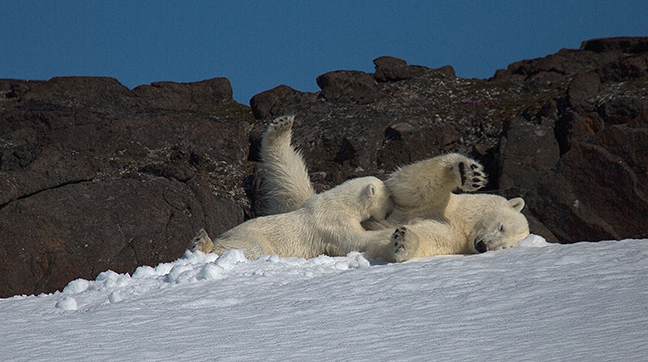
Polar Bears are the world’s largest land carnivores. Svalbard’s bears are part of the Barents Sea population which covers the area from Spitsbergen in the west to the Russian archipelagos of Franz Josef Land and Novaya Zemlya in the east. In Svalbard, the polar bear’s main prey are ringed and bearded seals and harp seals in offshore habitats. They feed almost exclusively on ice-living seals. A healthy adult polar bear kills between 50 and 75 seals annually to meet its energy requirements.
The harvesting of polar bears is regulated by a multilateral treaty signed in Oslo on November 15, 1973 by the five nations with the largest polar bear populations: Canada, Denmark (Greenland), Norway (Svalbard), the United States and the Soviet Union. Climate change is expected to cause serious problems for polar bears. Reductions in the ice pack will create difficulty in the hunting of seals and have a profound effect. Polar bears are also at risk from consuming prey that accumulated pollutants from lower trophic levels. (10/19)
©Rich Beckman

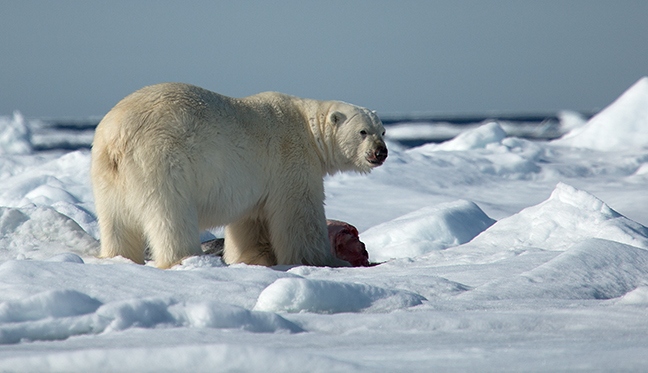
Polar Bears are the world’s largest land carnivores. Svalbard’s bears are part of the Barents Sea population which covers the area from Spitsbergen in the west to the Russian archipelagos of Franz Josef Land and Novaya Zemlya in the east. In Svalbard, the polar bear’s main prey are ringed and bearded seals and harp seals in offshore habitats. They feed almost exclusively on ice-living seals. A healthy adult polar bear kills between 50 and 75 seals annually to meet its energy requirements.
The harvesting of polar bears is regulated by a multilateral treaty signed in Oslo on November 15, 1973 by the five nations with the largest polar bear populations: Canada, Denmark (Greenland), Norway (Svalbard), the United States and the Soviet Union. Climate change is expected to cause serious problems for polar bears. Reductions in the ice pack will create difficulty in the hunting of seals and have a profound effect. Polar bears are also at risk from consuming prey that accumulated pollutants from lower trophic levels. (11/19)
©Rich Beckman

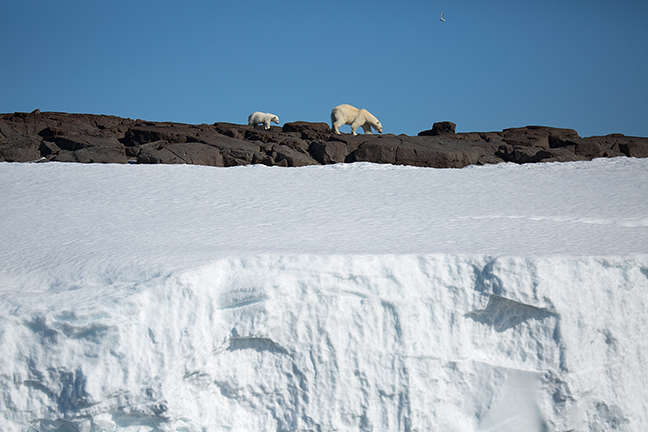
Polar Bears are the world’s largest land carnivores. Svalbard’s bears are part of the Barents Sea population which covers the area from Spitsbergen in the west to the Russian archipelagos of Franz Josef Land and Novaya Zemlya in the east. In Svalbard, the polar bear’s main prey are ringed and bearded seals and harp seals in offshore habitats. They feed almost exclusively on ice-living seals. A healthy adult polar bear kills between 50 and 75 seals annually to meet its energy requirements.
The harvesting of polar bears is regulated by a multilateral treaty signed in Oslo on November 15, 1973 by the five nations with the largest polar bear populations: Canada, Denmark (Greenland), Norway (Svalbard), the United States and the Soviet Union. Climate change is expected to cause serious problems for polar bears. Reductions in the ice pack will create difficulty in the hunting of seals and have a profound effect. Polar bears are also at risk from consuming prey that accumulated pollutants from lower trophic levels. (12/19)
©Rich Beckman

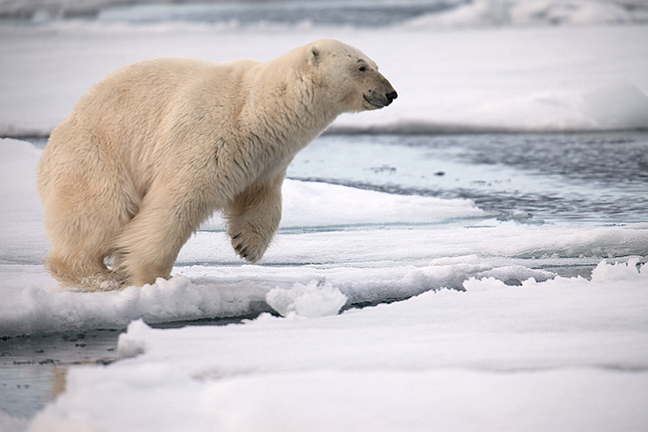
Polar Bears are the world’s largest land carnivores. Svalbard’s bears are part of the Barents Sea population which covers the area from Spitsbergen in the west to the Russian archipelagos of Franz Josef Land and Novaya Zemlya in the east. In Svalbard, the polar bear’s main prey are ringed and bearded seals and harp seals in offshore habitats. They feed almost exclusively on ice-living seals. A healthy adult polar bear kills between 50 and 75 seals annually to meet its energy requirements.
The harvesting of polar bears is regulated by a multilateral treaty signed in Oslo on November 15, 1973 by the five nations with the largest polar bear populations: Canada, Denmark (Greenland), Norway (Svalbard), the United States and the Soviet Union. Climate change is expected to cause serious problems for polar bears. Reductions in the ice pack will create difficulty in the hunting of seals and have a profound effect. Polar bears are also at risk from consuming prey that accumulated pollutants from lower trophic levels. (13/19)
©Rich Beckman

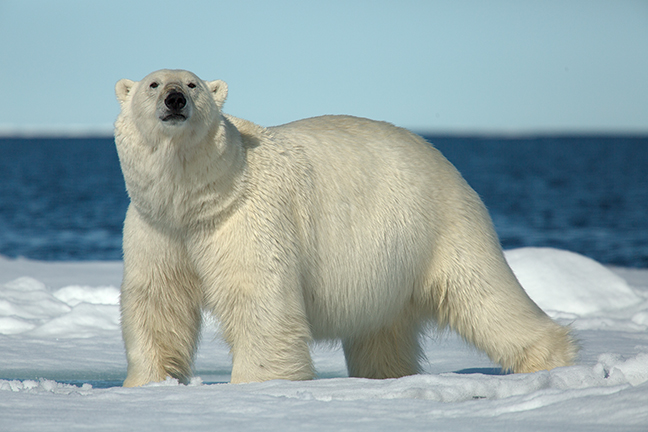
Polar Bears are the world’s largest land carnivores. Svalbard’s bears are part of the Barents Sea population which covers the area from Spitsbergen in the west to the Russian archipelagos of Franz Josef Land and Novaya Zemlya in the east. In Svalbard, the polar bear’s main prey are ringed and bearded seals and harp seals in offshore habitats. They feed almost exclusively on ice-living seals. A healthy adult polar bear kills between 50 and 75 seals annually to meet its energy requirements.
The harvesting of polar bears is regulated by a multilateral treaty signed in Oslo on November 15, 1973 by the five nations with the largest polar bear populations: Canada, Denmark (Greenland), Norway (Svalbard), the United States and the Soviet Union. Climate change is expected to cause serious problems for polar bears. Reductions in the ice pack will create difficulty in the hunting of seals and have a profound effect. Polar bears are also at risk from consuming prey that accumulated pollutants from lower trophic levels. (14/19)
©Rich Beckman

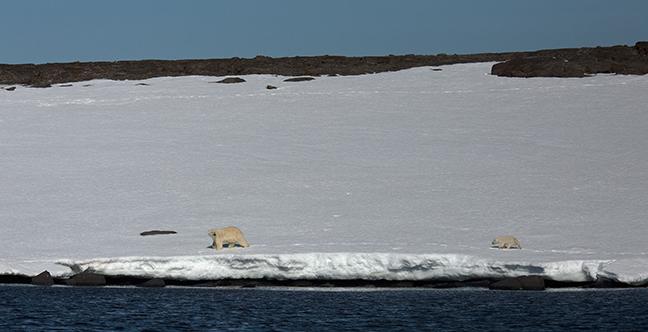
Polar Bears are the world’s largest land carnivores. Svalbard’s bears are part of the Barents Sea population which covers the area from Spitsbergen in the west to the Russian archipelagos of Franz Josef Land and Novaya Zemlya in the east. In Svalbard, the polar bear’s main prey are ringed and bearded seals and harp seals in offshore habitats. They feed almost exclusively on ice-living seals. A healthy adult polar bear kills between 50 and 75 seals annually to meet its energy requirements.
The harvesting of polar bears is regulated by a multilateral treaty signed in Oslo on November 15, 1973 by the five nations with the largest polar bear populations: Canada, Denmark (Greenland), Norway (Svalbard), the United States and the Soviet Union. Climate change is expected to cause serious problems for polar bears. Reductions in the ice pack will create difficulty in the hunting of seals and have a profound effect. Polar bears are also at risk from consuming prey that accumulated pollutants from lower trophic levels. (15/19)
©Rich Beckman

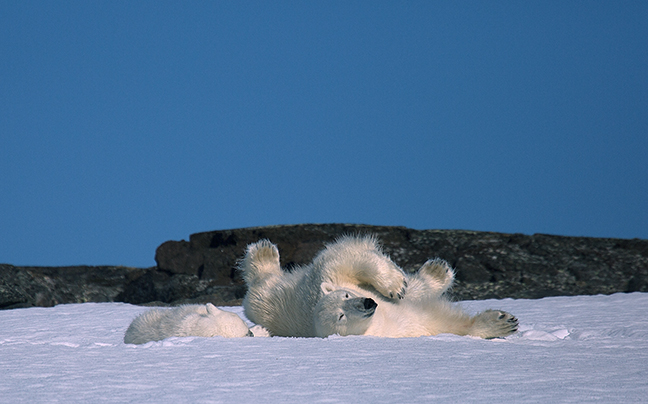
Polar Bears are the world’s largest land carnivores. Svalbard’s bears are part of the Barents Sea population which covers the area from Spitsbergen in the west to the Russian archipelagos of Franz Josef Land and Novaya Zemlya in the east. In Svalbard, the polar bear’s main prey are ringed and bearded seals and harp seals in offshore habitats. They feed almost exclusively on ice-living seals. A healthy adult polar bear kills between 50 and 75 seals annually to meet its energy requirements.
The harvesting of polar bears is regulated by a multilateral treaty signed in Oslo on November 15, 1973 by the five nations with the largest polar bear populations: Canada, Denmark (Greenland), Norway (Svalbard), the United States and the Soviet Union. Climate change is expected to cause serious problems for polar bears. Reductions in the ice pack will create difficulty in the hunting of seals and have a profound effect. Polar bears are also at risk from consuming prey that accumulated pollutants from lower trophic levels. (16/19)
©Rich Beckman

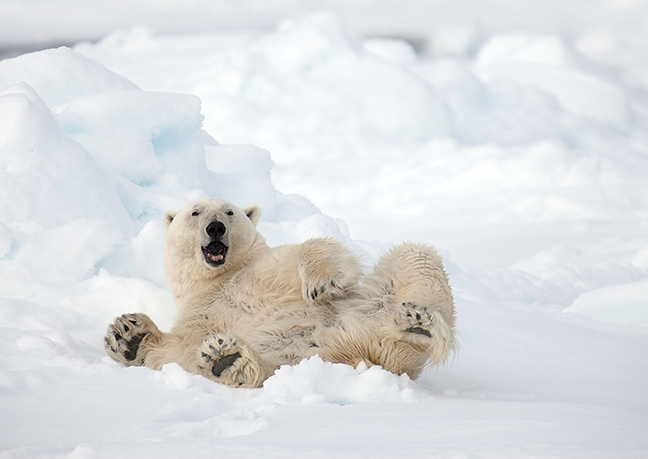
Polar Bears are the world’s largest land carnivores. Svalbard’s bears are part of the Barents Sea population which covers the area from Spitsbergen in the west to the Russian archipelagos of Franz Josef Land and Novaya Zemlya in the east. In Svalbard, the polar bear’s main prey are ringed and bearded seals and harp seals in offshore habitats. They feed almost exclusively on ice-living seals. A healthy adult polar bear kills between 50 and 75 seals annually to meet its energy requirements.
The harvesting of polar bears is regulated by a multilateral treaty signed in Oslo on November 15, 1973 by the five nations with the largest polar bear populations: Canada, Denmark (Greenland), Norway (Svalbard), the United States and the Soviet Union. Climate change is expected to cause serious problems for polar bears. Reductions in the ice pack will create difficulty in the hunting of seals and have a profound effect. Polar bears are also at risk from consuming prey that accumulated pollutants from lower trophic levels. (17/19)
©Rich Beckman

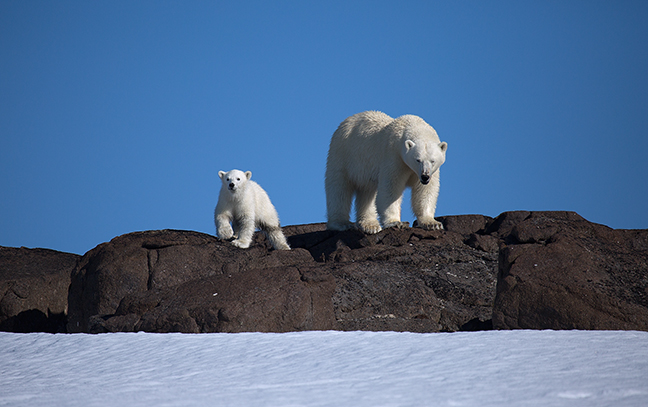
Polar Bears are the world’s largest land carnivores. Svalbard’s bears are part of the Barents Sea population which covers the area from Spitsbergen in the west to the Russian archipelagos of Franz Josef Land and Novaya Zemlya in the east. In Svalbard, the polar bear’s main prey are ringed and bearded seals and harp seals in offshore habitats. They feed almost exclusively on ice-living seals. A healthy adult polar bear kills between 50 and 75 seals annually to meet its energy requirements.
The harvesting of polar bears is regulated by a multilateral treaty signed in Oslo on November 15, 1973 by the five nations with the largest polar bear populations: Canada, Denmark (Greenland), Norway (Svalbard), the United States and the Soviet Union. Climate change is expected to cause serious problems for polar bears. Reductions in the ice pack will create difficulty in the hunting of seals and have a profound effect. Polar bears are also at risk from consuming prey that accumulated pollutants from lower trophic levels. (18/19)
©Rich Beckman

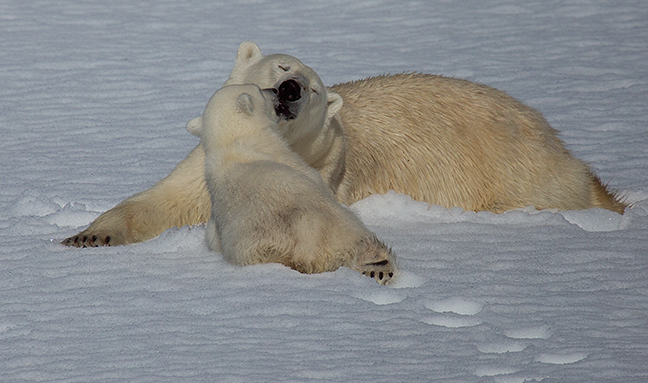
Polar Bears are the world’s largest land carnivores. Svalbard’s bears are part of the Barents Sea population which covers the area from Spitsbergen in the west to the Russian archipelagos of Franz Josef Land and Novaya Zemlya in the east. In Svalbard, the polar bear’s main prey are ringed and bearded seals and harp seals in offshore habitats. They feed almost exclusively on ice-living seals. A healthy adult polar bear kills between 50 and 75 seals annually to meet its energy requirements.
The harvesting of polar bears is regulated by a multilateral treaty signed in Oslo on November 15, 1973 by the five nations with the largest polar bear populations: Canada, Denmark (Greenland), Norway (Svalbard), the United States and the Soviet Union. Climate change is expected to cause serious problems for polar bears. Reductions in the ice pack will create difficulty in the hunting of seals and have a profound effect. Polar bears are also at risk from consuming prey that accumulated pollutants from lower trophic levels. (19/19)
©Rich Beckman